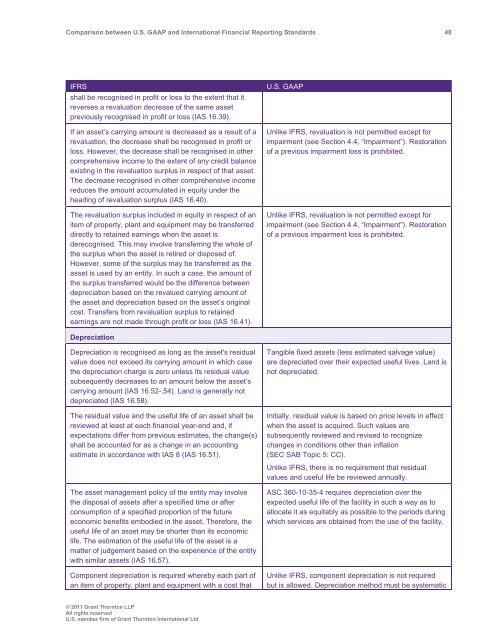Comparison between U.S. GAAP and International ... - Grant Thornton
Comparison between U.S. GAAP and International ... - Grant Thornton
Comparison between U.S. GAAP and International ... - Grant Thornton
Create successful ePaper yourself
Turn your PDF publications into a flip-book with our unique Google optimized e-Paper software.
<strong>Comparison</strong> <strong>between</strong> U.S. <strong>GAAP</strong> <strong>and</strong> <strong>International</strong> Financial Reporting St<strong>and</strong>ards 40<br />
IFRS<br />
shall be recognised in profit or loss to the extent that it<br />
reverses a revaluation decrease of the same asset<br />
previously recognised in profit or loss (IAS 16.39).<br />
If an asset’s carrying amount is decreased as a result of a<br />
revaluation, the decrease shall be recognised in profit or<br />
loss. However, the decrease shall be recognised in other<br />
comprehensive income to the extent of any credit balance<br />
existing in the revaluation surplus in respect of that asset.<br />
The decrease recognised in other comprehensive income<br />
reduces the amount accumulated in equity under the<br />
heading of revaluation surplus (IAS 16.40).<br />
The revaluation surplus included in equity in respect of an<br />
item of property, plant <strong>and</strong> equipment may be transferred<br />
directly to retained earnings when the asset is<br />
derecognised. This may involve transferring the whole of<br />
the surplus when the asset is retired or disposed of.<br />
However, some of the surplus may be transferred as the<br />
asset is used by an entity. In such a case, the amount of<br />
the surplus transferred would be the difference <strong>between</strong><br />
depreciation based on the revalued carrying amount of<br />
the asset <strong>and</strong> depreciation based on the asset’s original<br />
cost. Transfers from revaluation surplus to retained<br />
earnings are not made through profit or loss (IAS 16.41).<br />
U.S. <strong>GAAP</strong><br />
Unlike IFRS, revaluation is not permitted except for<br />
impairment (see Section 4.4, “Impairment”). Restoration<br />
of a previous impairment loss is prohibited.<br />
Unlike IFRS, revaluation is not permitted except for<br />
impairment (see Section 4.4, “Impairment”). Restoration<br />
of a previous impairment loss is prohibited.<br />
Depreciation<br />
Depreciation is recognised as long as the asset's residual<br />
value does not exceed its carrying amount in which case<br />
the depreciation charge is zero unless its residual value<br />
subsequently decreases to an amount below the asset’s<br />
carrying amount (IAS 16.52-.54). L<strong>and</strong> is generally not<br />
depreciated (IAS 16.58).<br />
The residual value <strong>and</strong> the useful life of an asset shall be<br />
reviewed at least at each financial year-end <strong>and</strong>, if<br />
expectations differ from previous estimates, the change(s)<br />
shall be accounted for as a change in an accounting<br />
estimate in accordance with IAS 8 (IAS 16.51).<br />
The asset management policy of the entity may involve<br />
the disposal of assets after a specified time or after<br />
consumption of a specified proportion of the future<br />
economic benefits embodied in the asset. Therefore, the<br />
useful life of an asset may be shorter than its economic<br />
life. The estimation of the useful life of the asset is a<br />
matter of judgement based on the experience of the entity<br />
with similar assets (IAS 16.57).<br />
Component depreciation is required whereby each part of<br />
an item of property, plant <strong>and</strong> equipment with a cost that<br />
Tangible fixed assets (less estimated salvage value)<br />
are depreciated over their expected useful lives. L<strong>and</strong> is<br />
not depreciated.<br />
Initially, residual value is based on price levels in effect<br />
when the asset is acquired. Such values are<br />
subsequently reviewed <strong>and</strong> revised to recognize<br />
changes in conditions other than inflation<br />
(SEC SAB Topic 5: CC).<br />
Unlike IFRS, there is no requirement that residual<br />
values <strong>and</strong> useful life be reviewed annually.<br />
ASC 360-10-35-4 requires depreciation over the<br />
expected useful life of the facility in such a way as to<br />
allocate it as equitably as possible to the periods during<br />
which services are obtained from the use of the facility.<br />
Unlike IFRS, component depreciation is not required<br />
but is allowed. Depreciation method must be systematic<br />
© 2011 <strong>Grant</strong> <strong>Thornton</strong> LLP<br />
All rights reserved<br />
U.S. member firm of <strong>Grant</strong> <strong>Thornton</strong> <strong>International</strong> Ltd
















